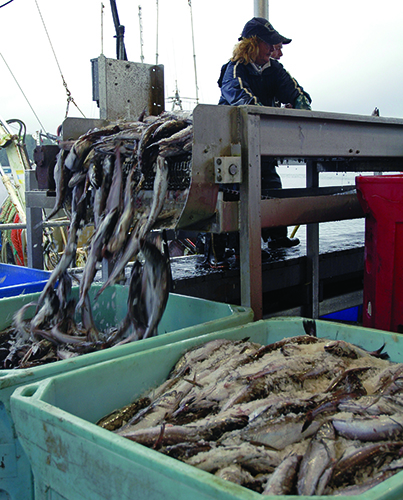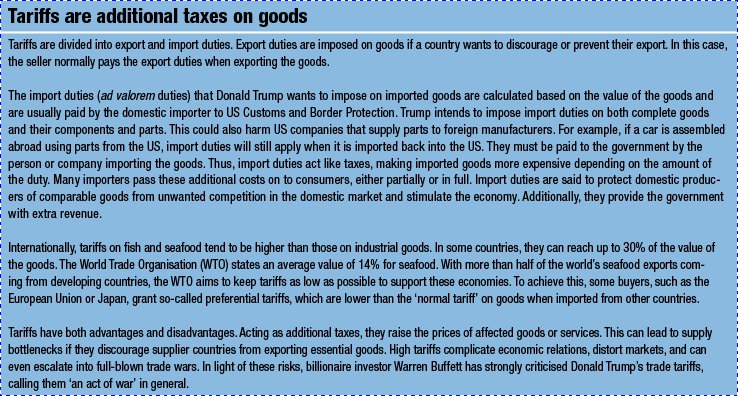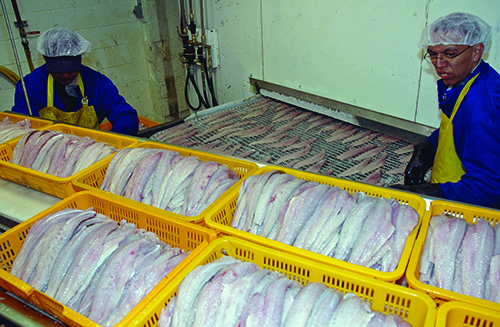A price surge for fish and seafood?
This article was featured in Eurofish Magazine 3 2025.
Since Donald Trump’s inauguration as the 47th President of the United States on 20 January 2025, the world has become much more turbulent. Hardly a day goes by without a new idea, announcement, or threat taking us by surprise. Positions once considered secure are being abandoned at a moment’s notice, giving the impression that not everything has been carefully thought through and planned. This is particularly true of the ‘punitive tariffs’ that Trump is so fond of imposing.
On the afternoon of 3 March, the period of uncertainty came to an end when US President Donald Trump announced that the 25% import tariffs on Mexico and Canada, which had been threatened a few weeks earlier, would come into force from the morning of the following day. The US has thus effectively nullified the USMCA (United States-Mexico-Canada Agreement), one of the largest free trade agreements in the world. The reason given for this consequential step was the allegedly inadequate engagement of both neighbouring countries in the fight against illegal migration and drug trafficking. The main issue here is the synthetic opioid fentanyl, which is legally used for medical purposes but has become a widely abused drug in the US. In a post on Trump’s Truth Social platform, the President wrote that the tariffs were imposed ‘because of the threat of illegal aliens and deadly drugs killing our citizens, including fentanyl’. According to the US Drug Enforcement Administration (DEA), more than 70,000 Americans died from fentanyl abuse in 2023. The danger is real, but the question arises as to whether this argument for the introduction of the ‘punitive tariffs’ is merely a pretext, as they are unlikely to have any real impact on curbing drug use. Trump’s executive order is entitled “Imposing Duties to Address the Flow of Illicit Drugs Across Our Northern Border”, which suggests that drug smuggling from Canada is a serious threat to the US. In reality, however, the quantities smuggled from there are likely to be relatively small. According to its own figures, US Customs and Border Protection seized only 19.5 kilograms of fentanyl at the northern border in 2024.
The real motive for the tariffs is likely to be the protectionist strengthening of the US economy, because America will only be ‘great again’ if the average American can feel the benefits in their daily life. Again, the question arises as to whether the introduction of additional tariffs, which severely disrupt established and proven global supply chains, is an appropriate means to this end. It is no secret that Trump and some of his advisers dislike the US trade deficit, which has accumulated over the years. In 2024, the deficit rose by 17% to a staggering $918.4 billion compared to 2023. Although US exports increased by 3.9% to $3,191.6 billion, imports rose even more sharply, by 6.6% to $4,110 billion. The largest trade deficits were recorded with China ($295.4 billion), the EU ($235.6 billion), Mexico ($171.8 billion), and Vietnam ($123.5 billion). For Trump, import tariffs are an effective way of reducing the US trade deficit and—even better—of encouraging foreign companies to relocate their production to the US. That is why the 47th President of the United States and self-proclaimed ‘dealmaker’ has rigorously enforced his tariff ideas—despite all protests and warnings of possible economic consequences. Many US voters were swayed by Trump’s promises to significantly reduce food prices. With these tariffs, Trump is now fulfilling one of his campaign promises. In doing so, he is even willing to accept the risk that the cost of living will rise rather than fall. The Peterson Institute for International Economics conducted a study in 2024, estimating that additional tariffs will result in extra costs of $2,600 per year for each US consumer. Furthermore, import tariffs could further drive inflation in the US.

Trump’s tariffs would hit the Canadian fishing industry hard, but they
would also have consequences for US consumers.
Imposing tariffs provokes resistance
China was the first to be hit, along with the US neighbours Canada and Mexico. In the period between the announcement of the tariffs and their imposition, negotiators tried in vain to persuade Trump to change his mind and avert the impending disaster. This was an almost impossible task, as the American side did not specify exactly what it expected in return for waiving the punitive tariffs. To deter migrants and drug couriers, Mexico extradited several dozen drug traffickers to the US and deployed more National Guard officers to the border. Canada invested in border security and appointed a commissioner to coordinate the fight against drug trafficking. The US administration was expected to take these efforts into account. On the eve of the imposition of tariffs, Mexico’s President Claudia Sheinbaum said they would wait calmly, “restrain their temper, be serious, and have patience”.
After talks with the heads of state, US President Trump agreed to postpone the punitive tariffs for a month, but on 4 March 2025, the threat was actually carried out. This is a far-reaching decision, as the US is Canada’s and Mexico’s most important trading partner. As a result, tariffs could push both economies into recession. Accordingly, Canadian Prime Minister Justin Trudeau strongly condemned Trump’s tariffs, calling them an economic attack on his country’s sovereignty that would not be accepted without resistance. Canada, in turn, imposed tariffs on US goods worth $155 billion. Trudeau called on Canadian citizens to respond by buying more domestic products. Mexico’s President Claudia Sheinbaum also ordered retaliatory tariffs against the US. At the same time, she strongly rejected Trump’s claim that the Mexican government had allied itself with criminal organisations. However, it is still unclear which countermeasures Mexico will adopt against US tariffs. Sheinbaum merely stated that the country was prepared and had appropriate plans.
Just three days after the tariffs were imposed, however, US President Trump backtracked again in the trade dispute with Canada and Mexico, partially suspending the tariffs for goods from both neighbouring countries—at least for the time being. Until 2 April, no punitive tariffs will apply to any imports covered by the North American Free Trade Agreement USMCA. The US administration’s erratic decisions are unsettling global markets and disrupting international trade relations.
Seafood exporter Canada particularly at risk
According to Seafood Source, higher import tariffs on goods from Canada, Mexico, and China would affect fish and seafood products worth over €5.3 billion. The additional costs for US seafood importers would amount to €1.12 billion. The US trade deficit, which Trump has frequently criticised, is particularly severe in the fish and seafood sector, as nearly 80% of the seafood consumed in the country is imported. That is why many of those affected within the US itself are hoping that cooler heads will prevail and action will be taken as soon as possible, because tariffs do more harm than good.
So, will tariffs be imposed or not? It is already apparent that the tariff dispute is disrupting the decades-old seafood trade structure between Canada and the US. Higher tariffs stall the engine of cross-border trade that benefits both countries. The impending chaos in the supply chains for salmon, lobster, snow crab, and many other products would lead to job losses, rising costs, and higher prices for consumers. In 2023, Canada imported a total of $3.4 billion worth of fish and seafood, with almost a third coming from the United States. In return, the United States imported over $3.6 billion worth of seafood from Canada, making Canada its largest supplier. The fishing industries of the two neighbouring countries are closely intertwined. For example, Trump’s tariffs would hit Canada’s lobster fishery hard, with 55% of its frozen and processed lobster exports going to the US. The Nova Scotia Seafood Alliance warns that well over 40% of the province’s wild-caught fish is shipped to trading partners in the south. The export of snow crab, the most valuable catch in Newfoundland and Labrador, is also at stake. 96% of the province’s crab exports, which generate more than $500 million annually, go to the US. Tariffs have the potential to slow down fishing and devastate coastal communities. This would not only affect the seafood industry, but also peripheral economic sectors, from freight forwarders and petrol stations to grocery stores, service providers, and many other industries. The Pacific province of British Columbia, which shipped fish and seafood worth $510 million to the United States in 2023, would also suffer significant damage.
Changing trade flows harm the US
At the same time, Trump’s threat to impose tariffs is already seen by Canada’s seafood industry as a ‘wake-up call’ to free itself from its one-sided dependence, diversify, and enter new markets. Initial reports indicate a particular focus on China, Europe, South Korea, and the Middle East. This reorientation may already be evident at the next seafood trade fair in Barcelona.
Compared to the tariffs against Mexico and Canada, the increase in tariffs for Chinese products as part of Trump’s controversial trade strategy seems almost ‘mild’. They will be doubled from 10% to 20% as of 4 March. It may not sound like much, but it is still significant, considering that the US imports more than $450 billion worth of products from China every year. The think tank Tax Foundation estimates that this increase in tariffs alone would mean an additional financial burden of $172 per US household. As expected, China is not accepting Trump’s decision on tariffs without a fight and has announced countermeasures. Beijing’s Ministry of Commerce stated that China will impose additional tariffs of 15% on chicken, wheat, corn, and cotton from the US from 10 March. Other agricultural products, including soybeans, pork, and beef, will be subject to an additional 10% tariff. This is strongly reminiscent of the previous trade war between China and the US, which Trump initiated with tariffs in 2018 during his first term in office. At the time, the escalating conflict cost US seafood importers at least $350 million, with different industries affected to varying degrees. For example, Maine’s lobster industry suffered an 84% decline in exports to China in 2019.

Current developments in the global seafood industry are seen as a
wake-up call in Canada and have increased pressure to diversify export markets..
It is in the nature of such deliberately provoked trade conflicts that even the instigator rarely escapes unscathed. Of course, US President Donald Trump is well aware of this, yet he claims that these measures will usher in ‘America’s golden age’. Some negative effects of tariffs are unavoidable for the American people, but he insists that, in the end, it will all be worthwhile. Whether this promise will be fulfilled remains open to doubt. Tariffs will have to be paid by US importers, further increasing the risk of inflation and forcing the Federal Reserve to tighten monetary policy. This, in turn, will make mortgages and other loans more expensive, which will ultimately be paid by consumers. The investment climate in the economy could suffer. The US stock market has already reacted negatively to the White House’s tariff threats. The leading US index, the S&P 500, lost 1.8% of its value over the course of the day, while the technology-heavy Nasdaq suffered even greater losses.
EU sees no trade deficit with the USA
Apparently, many investors hoped until the last moment that Trump might be bluffing. They miscalculated, as the US President remains undeterred and has already announced further tariffs on agricultural imports, which are expected to take effect from 2 April. Without providing further details, Trump has called on US farmers to boost production for the domestic market as a precaution.
The European Commission views Trump’s trade policy as a step in the wrong direction and continues to advocate for an open and predictable global trading system that benefits all stakeholders. At the same time, it refutes Trump’s claim that the EU was founded to ‘screw’ the United States. Contrary to Trump’s accusation that the EU benefits unilaterally from the trade relationship, the trade balance between the two partners is fairly even. The US President’s statement is based solely on bilateral trade in goods and fails to consider the value of bilateral trade in services. There is indeed a gap in goods trade. In 2023, the EU exported €503 billion worth of goods to the US, compared to €347 billion in imports from the US to Europe. This resulted in a €157 billion trade surplus in goods for the EU. However, Trump ignores the EU’s deficit in bilateral trade in services with the US. In 2023, the EU exported €319 billion worth of services to the US, compared to €427 billion in imports from the US to Europe. This resulted in a €109 billion trade deficit for the EU in services. Taking both goods and services into account, the EU has a small surplus of €48 billion with the US, which is just 3% of the total trade between the two economies (€1.6 trillion). Our economies are therefore highly complementary. In addition, EU and US companies are significant investment partners. In 2022 alone, reciprocal investments amounted to €5.3 trillion.

Even premium fish products, such as Pacific white halibut fletches,
would become significantly more expensive in the US retail market.
A return to economic reason is needed
Whether such arguments will convince the US President and dissuade him from imposing tariffs remains questionable. It seems that tariffs on cars, steel, and aluminium were decided long ago. This makes it all the more important to avoid them in the agricultural sector, where the EU also has close trade relations with the US. Of course, this also applies to fish and seafood. Higher US tariffs on fish and seafood products from the EU would affect shipments worth $1.4 billion. These include salmon, squid, fresh sea bass and sea bream, as well as cod fillets. On the other hand, the EU is also an important market for US seafood products, with Germany playing a particularly significant role. According to the USDA Foreign Agricultural Service, Germany is the largest fish and seafood market in Europe for US exporters. Imports of Alaska pollock play a particularly prominent role, but salmon, cod, live lobsters, and spiny dogfish are also in high demand. Interventions in these well-established trade relations, such as Trump’s threat of punitive tariffs, would severely disrupt this balanced system and have negative consequences for both sides. Manfred Klinkhardt




